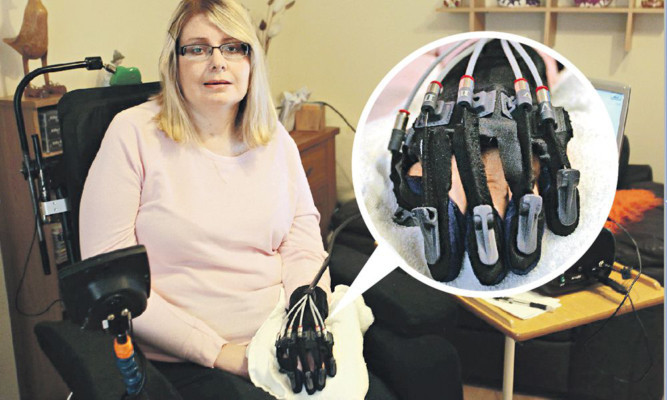
Britain’s longest ever locked-in syndrome sufferer has revealed how she has been able to move her hand with the help of a “bionic” glove.
For more than 17 years, Christine Waddell has been physically paralysed but completely mentally aware.
Neurologists doubted she’d ever regain movement as she was unable to eat, talk or walk unaided and could only communicate by blinking her eyes.
But determined Christine has now curled her fingers for the first time using a special Scottish-made robotic mitten. And she hopes it will signal the first tiny step to what she hopes could be a full recovery.
Revealing her joy, the 43-year-old said: “Super excited! Just noticed my fingers moving!”
The incredible breakthrough comes nearly two decades after Christine’s life changed forever. Aged just 26, she suffered a brain stem cell stroke in 1997, effectively cutting her brain off from her body.
Since then, she has only been able to communicate by flicking her eyes to spell out words for her carer or on an eye-tracking computer. But, over the last year, she has amazed her physiotherapist with her increasing strength and movement.
Christine has managed to stand up on her own and, just last month, she ditched the feeding tube which has been keeping her alive to eat solid food for the first time in years. Now she is working on moving her hands again, using the £4,000 computerised glove.
Christine, of Chester-le-Street, County Durham, is one of the first people in Britain to use the technology in her own home. It has allowed her independent movement in fingers on her left hand after a series of one-hour physiotherapy sessions.
Communicating via email, Christine told The Sunday Post: “I’m hoping in time to use it on both hands to regain normal movement once more. I had only been using it for three weeks when I noticed slight movements, so I am extremely optimistic.”
She said she hopes to use the new-found movement in her fingers to use a keyboard independently and communicate with other locked-in syndrome sufferers she has inspired across the globe.
Christine started her “Diary of a Fighter” group on Facebook in 2012 and now has hundreds of supporters following her amazing progress.
Her online fans include mum-of-three Kate Allatt, of Sheffield, South Yorkshire, who made a full recovery from locked-in syndrome and Malaysian teenager Ashley Tan, who developed locked-in syndrome when she was just 14.
She said: “It seems that the more recent cases of locked-in syndrome, turn to me for advice with me being 17 years into it. Apparently, a lot of locked-in sufferers and their loved ones find my progress very inspirational, so I’m really glad that some good is coming from my situation.”
The glove was provided by rehabilitation technology company Anatomical Concepts, based in Clydebank, West Dunbartonshire.
Director and company owner, Derek Jones said: “Christine was never expected to show any signs of improvement so the progress she has made has been fantastic.”
Locked in syndrome received widespread exposure thanks to sufferer Tony Nicklinson. He waged a right to die campaign which ended in failure. He died two years ago aged 58.
How does the glove work?
The Ghloreha, pronounced Gloria, runs computer-controlled cables over the hand to the fingertips. The cables work as the muscles and tendons would in the hand, gently un-clawing and wiggling the user’s fingers.
Made from lightweight material, it is attached to a touch-screen-operated computer, which the medic can programme with repetitive exercises. It gets the tendons, muscles and joints of the fingers all working together.
Clinical trials have shown that nearly a third more stroke patients will have more independent movement after using the glove for 30 or 40-minute sessions. The system was first used in the UK at the Queen Elizabeth National Spinal Injuries Unit in Glasgow.

Enjoy the convenience of having The Sunday Post delivered as a digital ePaper straight to your smartphone, tablet or computer.
Subscribe for only £5.49 a month and enjoy all the benefits of the printed paper as a digital replica.
Subscribe